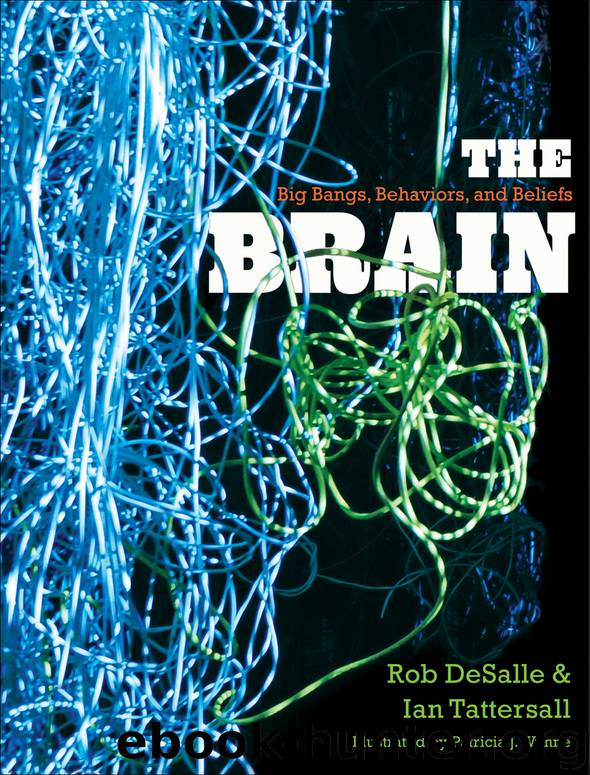The Brain by Rob DeSalle

Author:Rob DeSalle
Language: eng
Format: epub
Publisher: Yale University Press
Published: 2012-07-18T16:00:00+00:00
Not as Pretty as Heidi Klum but Nevertheless a Darn Good Model
Until recently, what we knew about memory came from two major kinds of scientific approach: studies of nonhuman brains that didn’t mind your telling them with whom to mate (the model organism approach) and studies of cracked-open human brains (the clinico-anatomical approach). In the first approach, there is an art to choosing a model organism for studying memory or indeed for any kind of biological study. One should choose not only something that won’t bite you but also a model that will have certain qualities that make it worth the trouble. Usually the researchers who choose the models are consummate naturalists who know something about the organism that they select that few others know. And through cleverly designed experiments, they take advantage of the traits of the model organism to uncover the mysteries of the genes, neural connections, and cells. An important nonhuman animal model for memory research is actually not the familiar Drosophila, the nematode, or even the mouse but the lowly sea slug Aplysia. Actually “lowly” is a misnomer, because sea slugs are every bit as related to us as is a nematode or a fly. They are all protostomes, and hence they share the same common ancestor with us. Aplysia was chosen as a model organism for studying memory by Eric Kandel of Columbia University, who chose this animal partly because it was easy to grow in the lab but mainly because it had nice big juicy nerve cells (up to 1 mm in diameter) and very few of them (twenty thousand total).
But Kandel also selected Aplysia because of its interesting behavior when prodded. This animal has what is affectionately called a “gill and siphon withdrawal reflex.” If one touches the siphon of the slug, this causes the siphon to contract and the gill to withdraw, like a worm crawling back into a hole, to protect these important protruding organs of the slug. It is an unspectacular response to a simple stimulus. With this response in mind, Kandel did what we call a classic “give it to the undergrad intern” experiment. When the slug extends its siphon again to feed, if the siphon is touched slightly once more, the gill and siphon will contract again, but not as rapidly and as extensively as the first time. Each time the siphon is touched, the degree of response by the slug is recorded. If this approach is repeated seventy to eighty times, with three-minute intervals between the stimulations, then by the seventy-ninth touch the slug will barely contract at all. The slug has “habituated” to the stimulation of the siphon. Classical habituation will erode after allowing the slug to rest for a while; indeed, if the undergrad goes out for lunch for two hours and comes back and touches the slug’s siphon (eightieth replicate), the response will be as extreme as when the experiment started. This form of habituation is similar to habituation in vertebrates and constitutes a form of nondeclarative memory.
Download
This site does not store any files on its server. We only index and link to content provided by other sites. Please contact the content providers to delete copyright contents if any and email us, we'll remove relevant links or contents immediately.
Sapiens: A Brief History of Humankind by Yuval Noah Harari(14166)
Sapiens by Yuval Noah Harari(5264)
Pale Blue Dot by Carl Sagan(4858)
Homo Deus: A Brief History of Tomorrow by Yuval Noah Harari(4777)
Livewired by David Eagleman(3624)
Origin Story: A Big History of Everything by David Christian(3590)
Brief Answers to the Big Questions by Stephen Hawking(3319)
Inferior by Angela Saini(3209)
Origin Story by David Christian(3117)
The Gene: An Intimate History by Siddhartha Mukherjee(3014)
Signature in the Cell: DNA and the Evidence for Intelligent Design by Stephen C. Meyer(2996)
The Evolution of Beauty by Richard O. Prum(2914)
Aliens by Jim Al-Khalili(2764)
How The Mind Works by Steven Pinker(2695)
A Short History of Nearly Everything by Bryson Bill(2578)
Sex at Dawn: The Prehistoric Origins of Modern Sexuality by Ryan Christopher(2441)
From Bacteria to Bach and Back by Daniel C. Dennett(2423)
Endless Forms Most Beautiful by Sean B. Carroll(2402)
Who We Are and How We Got Here by David Reich(2375)
